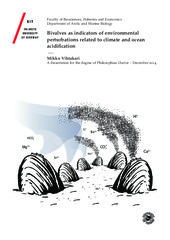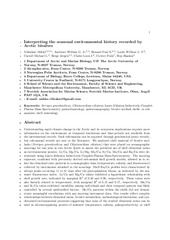| dc.contributor.advisor | Gulliksen, Bjørn | |
| dc.contributor.author | Vihtakari, Mikko | |
| dc.date.accessioned | 2015-02-18T11:23:35Z | |
| dc.date.available | 2015-02-18T11:23:35Z | |
| dc.date.issued | 2015-03-13 | |
| dc.description.abstract | The aims of this thesis were to increase knowledge on 1) susceptibility of bivalves to environmental perturbations and 2) usage of bivalve shells as sub-annual environmental proxy archives. These objectives were addressed using two experimental settings: 1) an ocean acidification (OA) experiment on bivalve gametes and early larval stages, and 2) year-long bivalve deployments on oceanographic moorings in two fjords in Svalbard followed by geochemical sampling of bivalve shells. The results indicate that Mytilus larvae are sensitive to ocean acidification, but global warming might have a larger impact on the larvae than acidification. Sperm activity of Mytilus galloprovincialis males was negatively affected by the high-end OA scenarios for the year 2100, possibly indicating a reduced fertilization success in low-density populations. Individual males demonstrated different tolerances of OA indicating that Mytilus populations might have the capacity to adapt to moderate reductions in ocean pH. Shell growth rate of Serripes groenlandicus and Ciliatocardium ciliatum correlated with temperature, and the length of the growth season was likely determined by food availability. Both species deposited a prominent winter growth line, which can be used as an indicator of low food availability. Despite the high potential as sub-annual environmental proxies, interpretation of elemental ratios in Serripes groenlandicus and Ciliatocardium ciliatum shells is complicated by multiple internal and external factors: Li/Ca could partly reflect calcium carbonate crystal growth rate, Mg/Ca was loosely connected with temperature, and Ba/Ca could reflect the elemental ratio in seawater. None of these ratios, however, can be used as straightforward proxies of temperature, salinity, fluorescence or shell growth rate. The insights into sub-annual growth of Arctic bivalves and the methods to align sample spots along chronologically deposited materials, as provided by this thesis, can be used in further proxy development studies. | en |
| dc.description.doctoraltype | ph.d. | en |
| dc.description.popularabstract | Materialet til avhandlingen ble skaffet gjennom 1) Havforsurings-eksperiment på kjønnsceller og tidlige larvestadier av Middelhavsblåskjell 2) Utplassering av arktiske muslinger på oseanografiske rigger i to fjorder på Svalbard i ett år etterfulgt av geokjemisk analyser av muslingskallene. Resultatene indikerte at vekst hos blåskjell larver kan bli negativt påvirket ved moderate havforsurings-scenarier anslått for året 2100, men økende temperatur kan ha større påvirkning på larvene. Spermaktivitet hos hanner av Middelhavsblåskjell ble negativt påvirket av de mest ekstreme havforsurings-scenarier for 2100, indikasjon på en lavere suksess for befruktning hos populasjoner av skjell med lave tettheter. Spermier fra Middelhavsblåskjell viste betydelig variasjon i respons til havforsuring. Dette kan indikere at blåskjellpopulasjoner har evne til å tilpasse seg moderate reduksjoner i havets pH. Skallveksten til de to musling-artene på de oseanografiske riggene var korrelert med sjøtemperatur, og vekstsesongens lengde ble trolig bestemt av sesongmessig næringstilgang. Muslinger har potensiale som miljøindikatorer, men tolkningen av elementære forhold i skjell er komplisert fordi reguleringen styres av både interne og eksterne faktorer. | en |
| dc.description.sponsorship | The projects in this thesis were funded through University of Tromsø Utenlandstipend, EU 7th Framework Program project Arctic Tipping Points, the Fram Centre Ocean Acidification Flagship, the Research Council of Norway project Havet og Kysten, the Norwegian Polar Institute, and Akvaplan-niva. | en |
| dc.description | | en |
| dc.identifier.uri | https://hdl.handle.net/10037/7152 | |
| dc.identifier.urn | URN:NBN:no-uit_munin_6745 | |
| dc.language.iso | eng | en |
| dc.publisher | UiT The Arctic University of Norway | en |
| dc.publisher | UiT Norges arktiske universitet | en |
| dc.rights.accessRights | openAccess | |
| dc.rights.holder | Copyright 2015 The Author(s) | |
| dc.rights.uri | https://creativecommons.org/licenses/by-nc-sa/3.0 | en_US |
| dc.rights | Attribution-NonCommercial-ShareAlike 3.0 Unported (CC BY-NC-SA 3.0) | en_US |
| dc.subject | VDP::Mathematics and natural science: 400::Geosciences: 450::Mineralogy, petrology, geochemistry: 462 | en |
| dc.subject | VDP::Matematikk og Naturvitenskap: 400::Geofag: 450::Mineralogi, petrologi, geokjemi: 462 | en |
| dc.subject | VDP::Mathematics and natural science: 400::Zoology and botany: 480::Marine biology: 497 | en |
| dc.subject | VDP::Matematikk og Naturvitenskap: 400::Zoologiske og botaniske fag: 480::Marinbiologi: 497 | en |
| dc.subject | VDP::Mathematics and natural science: 400::Zoology and botany: 480::Ecology: 488 | en |
| dc.subject | VDP::Matematikk og Naturvitenskap: 400::Zoologiske og botaniske fag: 480::Økologi: 488 | en |
| dc.title | Bivalves as indicators of environmental perturbations related to climate and ocean acidification | en |
| dc.type | Doctoral thesis | en |
| dc.type | Doktorgradsavhandling | en |


 English
English norsk
norsk




